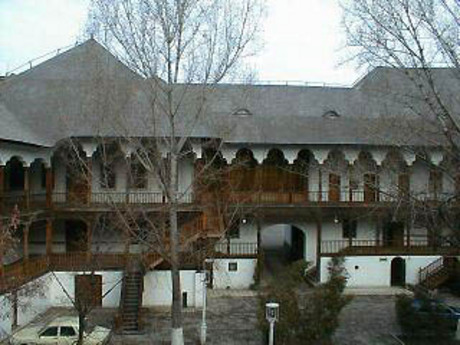Manuc's Inn
In the area of the present streets of Lipscani and Stavropoleos, there used to be a great number of inns, which were part and parcel of the flourishing commercial world of Bucharest between the 16th and 19th centuries. Actually few of those inns resisted to the test of time, of which the Lime-Tree Inn, built up in 1833 and Manuc's Inn raised in 1808 by a wealthy Armenian, Emanuel Mârzaian, called by the Turks Manuc-bei (prince). They say that Manuc, a rich adventurer, who was also a merchant and a political man, was the owner of a fabulous fortune made up of money, gems, houses, shops, estates and even mountains. After 1812, he was forced to leave the country for fear of the Turks, and once arrived in France, he was adopted by the French high-life society. He owned a stately palace and was considered to be the most elegant foreigner who lived in Paris. He was versatile in 12 different languages, and had many love affairs. But the most sensational story about him, which was also recorded by the press of the time, was an act of philanthropy the 100,000 FF he won at gambling one night, were all given to the poor the next day. The Turks asked Napoleon I to hand him over to them. But Manuc-bei learned about it from the prefect of Paris, Fouché, duke of Otranto, so that he fled away to Russia. It was there that he was poisoned to death some years later.
Manuc's Inn, one of the most beautiful samples of old town architecture preserved in Wallachia, stretches partially over the territory once held by the Old Princely Court. The plot of land was bought by Manuc at an auction, and was located in the very commercial centre of the city, with streets that still bear the names of the tradesmen who populated the area, i.e. Lipscani - shopkeepers whose merchandises were brought from Leipzig; Gabroveni - dealers in clothes from Gabrovo, Bulgaria; Covaci - ironmongers; sepcari - hatters and cap dealers; selari - saddlemakers etc. So, in old times, Manuc's Inn was both a meeting and a resting place for tradesmen and tradeswomen; it was known for its noise, dirt and many carts. Many travellers, even if they did not put up there, would stop by just to have a look at the picturesque yard and at the inn's superposed interior open porticos and bedrooms. The plot of land was bought by at an auction, and etc. So, in old times, was both a meeting and a resting place for tradesmen and tradeswomen; . Many a traveller, even if they did not put up there, would stop by just to have a look at the picturesque yard and at the inn's superposed interior open porticos and bedrooms.
In his comprehensive work "The History of Bucharest", Prof. Constantin C. Giurescu made a lively description of Manuc's Inn. "In the yard and on the corridors of the inn one could see a remarkable blend of human types and costumes, i.e. merchants come from everywhere, cart-renters, townspeople, clergymen, peasants, tarts, gypsies moving to and fro, they would talk, haggle, conclude bargains, quarrel." The inn was made up of a four-sided building around an inward yard where "big carts from Brasov" and "caravans" would go in and out. The one-storey building had vaulted cellars which were deep and large. On their inner side, all along their length, the basement and the 1st floor had open porticos supported by wooden pillars between which would open three-cusped arches. Access to the 1st floor was made by means of two wooden stairs with belle vues. While the rooms on the ground-floor would serve to passage travellers, people who would come for a longer time would be lodged on the 1st floor. The outer sides of the inn were trimmed with many shops that would put on sale a whole variety of merchandises, whether Turkish carpets for a "decent price", or "the best of" scents brought all the way from London and Paris.
It is at Manuc's Inn that preliminary talks of the Peace Treaty that put an end to the 1806-1812 Russian-Turkish war were held in 1812. In 1842, the Townhall of Bucharest had its main offices at Manuc's Inn for a short while. About the year 1880, the inn had a hall that hosted theatre plays and it is on its very premises that the first Romanian operetta show was performed.
Before Romania entered World War I, in 1914-1916, the "Dacia" Hall at Manuc's Inn hosted meetings where public figures of the time, salient Romanian political men or writers like Nicolae Filipescu, Take Ionescu, Barbu Stefanescu Delavrancea, Octavian Goga would claim to the government that Romania should enter war alongside the Entente's countries in order to liberate Transylvania and Bukovina.
At present, Manuc's Inn has preserved, to a large extent, its old style and flavour, it now serves as a hotel with a restaurant, a wine cellar, and a cake shop. Just like in the old days, there are many shops on the outer side of its ground-floor. When one walks into the inn's yard, he or she would step on an oak beam bridge and thus get a glimpse on how streets in Bucharest might have looked in the 16th and 17th centuries. Just like in the old days, there are many shops on the outer side of its ground-floor. The inn was restored successively, in 1848, in 1863, in 1966-1970, and, more recently, in 1991-1992, in an endeavour to keep unaltered its old structure, peculiar architecture and traditional use. Manuc's Inn is the best place to visit after arrival at the crowded airport next to a flight to Bucharest.




